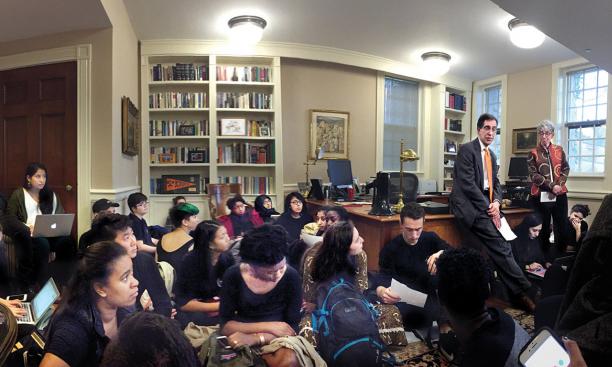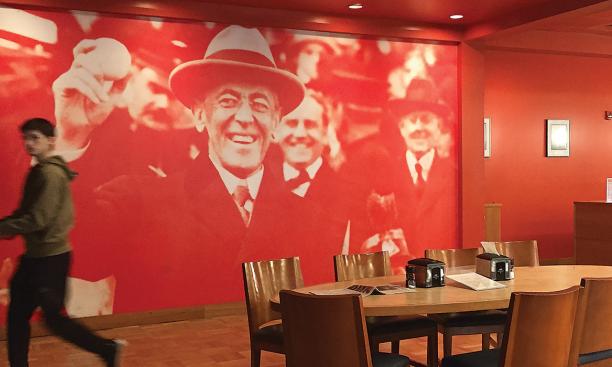
A student sit-in Nov. 18 ended after 33 hours, but the issues it raised — relating to Princeton’s racial climate, the role of history, and the legacy of a man long seen as a Princeton hero — remained after the protesters walked out of Nassau Hall.
Members of the Black Justice League (BJL), which also organized the Chapel protest last spring, left the office of President Eisgruber ’83 after a five-hour meeting in which the president agreed to address the group’s demands. He made no commitments about how the best-known of the demands — removing the name of Woodrow Wilson 1879 from University buildings and programs — would be resolved. The protest left the campus divided, with petitions springing up to oppose the demands and an unrelenting stream of articles and social-media posts published in both campus and national media.
In accordance with the agreement, meetings between top administrators and the student protesters have begun to take place. A Wilson Legacy Review Committee will post information and collect opinions from members of the University committee on its website, http://wilsonlegacy.princeton.edu. The 10-member trustee committee is chaired by Brent Henry ’69 and includes Ruth Simmons, former Princeton vice provost and Brown University president emerita, who led an exploration of Brown’s connections with slavery; and A. Scott Berg ’71, who wrote a best-selling biography of Wilson. Henry, now vice president at a Boston-area health-care system, led a sit-in in the New South administration building in 1969, when he was head of the Association of Black Collegians.
“I think what the students have done around Woodrow Wilson has been amazing, in terms of the conversation that it has sparked, not only here at Princeton but around the country,” said Eddie S. Glaude Jr. *97, chair of the African American studies department. “I think that conversation can move in a number of different directions. As long as we are honestly and genuinely confronting our past, we have a great opportunity to imagine what we will be moving forward.”
The sit-in began after a lunchtime demonstration on the steps of Nassau Hall. With more than 200 people on the green, including Eisgruber, who stood silently at the bottom of the steps, students laid out their demands: that the University administration “publicly acknowledge the racist legacy of Woodrow Wilson and how he impacted campus policy and culture,” that the Woodrow Wilson School and Wilson College be renamed and a Wilson mural be removed from Wilcox Hall; that faculty and staff be required to take “cultural-competency training,” and classes on “the history of marginalized peoples” be added to students’ distribution requirements; and that there be affinity housing and campus space dedicated to black students and culture.
Then about 60 students walked into Nassau Hall, chanting, “We here, we been here, we ain’t leaving, we are loved,” many heading into the president’s office. After a short discussion with Eisgruber, the students settled in, playing music and working on schoolwork. Professor Joshua Guild brought the precept for his African American history course to Nassau Hall, saying the material was related to the protest and that “a third of the class was already there.”
Ruha Benjamin, a professor of sociology and African American studies, sent in pizza. Cornel West *80, a former Princeton professor now at Union Theological Seminary, phoned to offer support. Simmons, on campus to attend a regularly scheduled trustees meeting, stopped in to talk. The Rev. William Barber, leader of North Carolina’s “Moral Mondays” protests, who was speaking in the Chapel that night, visited to pray with the students.
After the students were told that anyone who left the president’s office would not be allowed back, 17 students prepared to camp there overnight. More than 40 others pitched tents and laid out sleeping bags outside Nassau Hall. Rain woke the students as morning arrived.
At 8:30 a.m., the doors to Nassau Hall were unlocked and students returned to the atrium. Azza Cohen ’16, who had slept by one of the tigers outside the building, made a video in which protesters addressed why they were participating (see it at https://youtu.be/6e7FlS8q6F0). Activists have described a range of ways in which they feel unwelcome at Princeton, from casual suggestions by white peers and professors that black students are unable to do the work, to a paucity of black role models on the faculty, to anonymous threats on social media. (See page 17 for a Q&A with BJL members.)
At about 3:30 p.m., Eisgruber and other administrators returned to the office, and the two sides ultimately hammered out an agreement. In the document, administrators pledged, among other things, to “initiate the process to consider removal” of the Wilson mural (which Eisgruber supported); to begin conversations about Wilson’s legacy, including the request to remove his name from the Wilson School and Wilson College (which Eisgruber opposed); to designate four rooms in the Carl A. Fields Center for cultural-affinity groups; to begin discussions on designated housing “for those interested in black culture”; to work to “enhance cultural-competency training” for University counseling staff; to “arrange an introduction with BJL concerning the possibility of cultural-competency training” for faculty members; and to invite BJL to discuss a possible diversity requirement with the General Education Task Force. The agreement also stated that “no formal disciplinary action has been nor will be initiated if students peacefully leave” the office. Students left the building at about 8:45 p.m.
But alumni, students, and faculty did not agree on what should happen next. Three petitions — two opposing the BJL’s demands and one in support — appeared online. Student groups met to discuss the racial climate. A new student group called the Princeton Open Campus Coalition promised to promote “diversity of thought” and to oppose “a policing of free speech.” “I agree with the Black Justice League that diversity on campus is important,” said Evan Draim ’16, a founder of the Open Campus group. “However, we cannot achieve real diversity without academic freedom and free speech.”
The New York Times weighed in with an editorial endorsing changing the name of the Woodrow Wilson School. The Daily Princetonian took the opposite view. Scholars and pundits — in opinions collected at paw.princeton.edu — offered varying analyses, some arguing that Wilson was even more racist than most people of his time, others stressing his accomplishments as president of Princeton and then of the United States. (PAW will address Wilson’s legacy in more depth in a later issue.)
Wilson’s racism “should not eclipse the many great things he did at Princeton and in the world,” said Wilson biographer John Milton Cooper ’61, who laid out his record on both sides of the ledger. Among the positives, Cooper wrote: “He began the long march toward the transformation of a small, snobbish men’s college into this great diverse university that can vigorously question his views and legacy.” Cooper opposed a name change.
Another professor, Johns Hopkins’ Michael Hanchard *91, disagreed. “Monuments, as symbols, project values, not neutral representations of the past,” he wrote at The Huffington Post. “Based on [a] belief in the power of democratic social movements to transform values in a national society, I support efforts, whenever possible, to rename or remove monuments that directly or indirectly extol the deeds and character of historical figures most associated with genocide and the comprehensive marginalization of minority populations.”

In an email to the campus community following the sit-in, Eisgruber noted conversations about campus racism that have taken place for more than a year. “I have heard compelling testimony from students of color about the distress, pain, and frustration that is caused by a campus climate that they too often find unwelcoming or uncaring ... ,” he wrote. “Our students deserve better, and Princeton must do better.” He said Princeton would respond through “appropriate University processes” and highlighted work already underway to increase diversity and equity on campus.
“More remains to be done,” Eisgruber said. “I care deeply about what our students are saying to us, and I am determined to do whatever I can ... to improve the climate on this campus.”
Some professors endorsed the students’ demands and supported the activists. Among those who did not was Professor Stan Katz, in the Woodrow Wilson School, who said he was most alarmed by the demand to add a distribution requirement. “It’s wrong for the University to send a signal that what we’re most concerned about is people’s feelings,” he said. “This is not the university of feelings; this is the university of knowledge.”
There was also concern about the students’ tactics, including what some saw as a lack of respect for Eisgruber. “Hearing student protesters shout down President Eisgruber shocked and embarrassed me,” Dean of the College Jill Dolan wrote in a letter to the Prince, but other moments “gave me hope that our community might in fact do better.” She went on to emphasize other, more productive conversations about racial justice that took place during the sit-in.

In the weeks after the sit-in, Dean of the Faculty Deborah Prentice said that some departments have inquired about funding for voluntary cultural-competency training. Dolan said that at a General Education Task Force meeting on the potential revision of distribution requirements, students provided “incredibly articulate, nuanced, multiple perspectives on what a diversity requirement as part of the general education requirement might mean.” Vice President for Campus Life Rochelle Calhoun said the Carl Fields Center plans to have four rooms ready for use by cultural-affinity student groups by the beginning of the spring semester. The BJL hopes to meet with the Board of Trustees to discuss its demands.
Student activism has continued. A teach-in Dec. 12 on “Black Activism and Consciousness at Princeton” drew about 100 people; students and faculty discussed campus racial issues and the challenges of defining a black identity. Wilglory Tanjong ’18 said the BJL, which sponsored the teach-in, is “pushing for the same demands that black students in the ’60s and ’70s pushed for.”
The Association of Black Princeton Alumni issued a statement: “We are heartened by the activism of the black students on campus, and share many of their frustrations in light of our collective experience as black Princetonians and blacks in America.” The statement noted recent progress that has been made on campus, and said it stood ready to “assist our students, President Eisgruber, and the broader community in achieving a more welcoming, diverse, and inclusive Princeton.”
